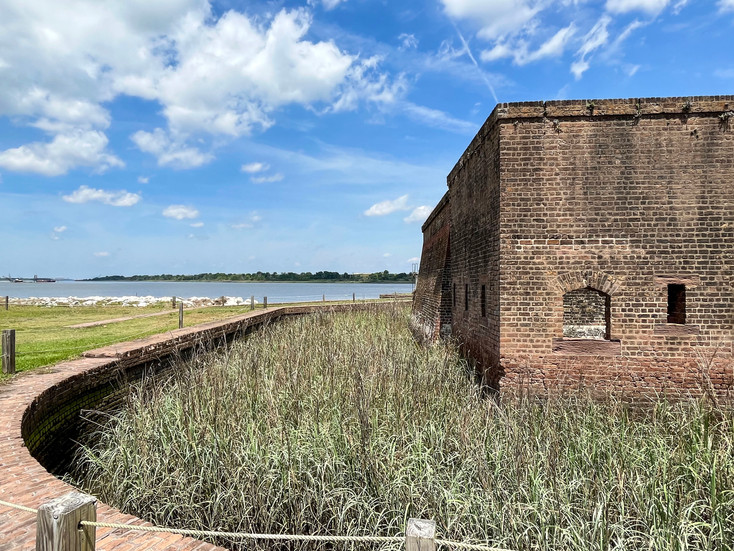Old Fort Jackson
- Tim Murphy
- Sep 7
- 6 min read
Located within the historic urban landscape of Savannah, Georgia, Old Fort Jackson stands with subtle significance as one of the nation’s best preserved examples of Second System architecture. Its strategic importance was paramount in the defense of Savannah, providing invaluable insights into early American military engineering and coastal defense strategies.
The Savannah River was integral to Georgia’s economic viability, functioning as the primary artery for colonial commerce and transportation. Nevertheless, at the onset of the Revolutionary War, this vital shipping channel remained largely unprotected, thereby exposing Savannah to British attack. Recognizing this vulnerability, the Georgia Executive Council allocated $3,000 in September 1777 to construct defensive works on Salter’s Island—a tactical riverfront position protecting the port city's approach. By February 1778, a rudimentary earthen battery named Mud Fort had been installed. A detachment from the Continental Army’s First Georgia Battalion, under command of Captain Thomas Lee, garrisoned the island. Unfortunately, the fort's swampy location proved disastrously unhealthy. Malaria ran rampant throughout the camp. High mortality rates (including the death of Captain Lee) rendered the position untenable, forcing the Continental Army to withdraw. The lack of formidable intracoastal defenses ultimately contributed to the British seizure of Savannah later that December.

In 1808, amidst escalating tensions with Great Britain, President Thomas Jefferson's administration authorized plans for the Second System of Coastal Defense—an ambitious program aimed to fortify strategic American ports against potential naval attack. As part of this initiative, a new brick masonry fort was commissioned for the former site of Mud Fort. This installation was named Fort James Jackson, honoring the Revolutionary War veteran who accepted the British surrender of Savannah in 1782. Jackson also held numerous political roles, serving in the House of Representatives (1789 – 1791), U.S. Senate (1793 – 1795, 1801 – 1806), and as Governor of Georgia (1798 – 1801). Supervising the new fort’s construction was Captain William McRee—a twenty-year-old West Point graduate and future Surveyor General of the United States.
Completed in 1812, Fort James Jackson was considered one of the most formidable forts in America. Its original design featured a semicircular riverfront battery—a casemated earthwork reinforced with “Savannah Gray” brick—and a wooden palisade that enclosed the landward side.
During the War of 1812, Fort James Jackson was garrisoned by elements of the 8th U.S. Infantry Regiment and local militia units, including the Republican Blues and Chatham Artillery, though it never saw any combat. Following the war's conclusion in 1815, state and federal troops withdrew, and the fortification quickly deteriorated. As one local newspaper described in 1819, “ Fort Jackson (is) one of the most distempered spots on earth, in the midst of fogs and poisons of a putrid marsh.” Beginning in 1821, the fort was briefly reoccupied by Company H, 4th U.S. Heavy Artillery; however, deadly Yellow Fever outbreaks forced the garrison to relocate to Tybee Island in September 1823. Fort James Jackson remained virtually abandoned for the next two decades.
In 1845, Congress appropriated funds to modernize Fort Jackson, intending it to serve as a strategic complement for the more advanced Fort Pulaski, which guarded the entrance to the Savannah River. The Army Corps of Engineers spent the next fifteen years reinforcing the fort’s exterior walls, erecting new soldiers’ barracks, and installing a protective moat. However, these renovation efforts were abruptly suspended on January 26, 1861, when Fort Jackson was “forcibly taken by the authorities of the state of Georgia,” as documented by Lieutenant William Henry Chase Whiting, the fort’s supervising engineer.

Although never heavily engaged during the American Civil War, Fort James Jackon played a significant role in the defense of Savannah. Following the unprecedented loss of Fort Pulaski in April 1862, Fort Jackson became the headquarters for the Confederacy’s Savannah River Defenses—an integrated network of earthen batteries and underwater obstructions deliberately arranged to safeguard the strategic port city from Union naval campaigns.
The Confederate ironclad C.S.S. Georgia, colloquially known as the "Ladies' Gunboat," constituted another vital component of Savannah's defenses. In March 1862, the Ladies' Gunboat Association launched a statewide fundraising campaign to construct an ironclad vessel for the protection of Georgia’s vulnerable coastal communities. Through an impressive grassroots effort, the Ladies received over $75,000 in donations. Construction began almost immediately; however, due to a wartime shortage of iron, the Georgia’s wooden hull was covered with overlapping railroad tracks. This unconventional armor rendered the ship too ponderous to navigate the powerful Savannah River tides. Impractical as a mobile warship, the Georgia was towed into a defensive position opposite Fort James Jackson, where it served as a floating battery.
The Savannah River Defenses kept the Union Navy at bay for most of the Civil War; however, the strategic threat against Savannah eventually shifted from a maritime to an overland approach. In December 1864, Major General William T. Sherman’s Military Division of the Mississippi (approximately 62,000 Union soldiers) was heavily engaged in its “March to the Sea.”—an attritional campaign that wrought immense destruction through the heart of Georgia. Sherman’s ultimate objective was to capture Savannah and open a requisite supply line with Union vessels in the Atlantic. Opposing Sherman was Confederate General William J. Hardee, whose disparate command numbered only 12,000 troops. Confronted with overwhelming odds, Hardee decided to evacuate Savannah and its surrounding defenses on December 20, 1864. Before retreating into South Carolina, the Confederate garrison at Fort James Jackson destroyed its barracks, artillery pieces, and ammunition. This preemptive action was paralleled by the crew of the C.S.S. Georgia, who scuttled their ironclad to deny its seizure by Union forces.
On the morning of December 21, elements of the 28th Pennsylvania and 29th Ohio Volunteer Infantry regiments secured Fort James Jackson. As Union troops raised the American flag, the Confederate ironclad C.S.S. Savannah launched a brief but ineffective bombardment against the captured position. The Savannah hastily withdrew upriver, where she was set ablaze by her crew.

After the Civil War, Fort James Jackson was briefly utilized as a quarantine station for the Port of Savannah while army engineers removed Confederate ordnance from its environs. Between 1869 and 1875, the Savannah District Corps of Engineers received intermittent funds to preserve and repair military installations under their jurisdiction; however, little work was accomplished during that time, as the development of rifled artillery had rendered masonry fortifications obsolete for coastal defense.
In 1884, Fort James Jackson was temporarily renamed Fort Oglethorpe in honor of Georgia’s founder Lieutenant General James Edward Oglethorpe; however, the War Department reinstated the original name in 1905. Since then, the site has been commonly known as “Old Fort Jackson.”
Following the United States’ entry into World War II, Old Fort Jackson was acquired by Southeastern Shipyards—Savannah’s single largest wartime employer that produced over eighty Liberty ships and minesweepers. In 1955, the fort was purchased by the American Cyanamid Company, which initiated efforts to preserve the historic structure. In 1965, the Georgia Historical Commission obtained the property and operated a museum on site until state budget cuts forced its closure in 1975. Old Fort Jackson was subsequently acquired by the Coastal Heritage Society and reopened to the public in September 1976.

The Coastal Heritage Society has since expanded the fort's educational programs and restored numerous structures, offering dedicated history enthusiasts a tangible connection to nineteenth-century military life and engineering. Visitors can immerse themselves within Old Fort Jackson’s casemates, which house several displays detailing its construction, garrison life, and historical significance. The experience is further enhanced by living history elements, including daily weapons demonstrations and interactions with knowledgeable historical interpreters.
A distinctive example of Second System engineering, Old Fort Jackson possesses an architectural character that is undoubtedly captivating to military historians. However, it maintains limited appeal for a broader audience, primarily due to its sparse exhibitions and unadorned appearance. In a city like Savannah, which boasts a wealth of historical attractions, Old Fort Jackson is often overshadowed by more accessible and engaging alternatives.
Visit the Coastal Heritage Society for more information on Old Fort Jackson's operating hours and event schedules
Check out the National Park Service, Explore Southern History, Savannah Explored, Cochran Writing, and Star Forts for more historical information about Fort James Jackson
Learn more about the C.S.S. Georgia by visiting the Texas A&M Nautical Archaeology Program and Emerging Civil War





























